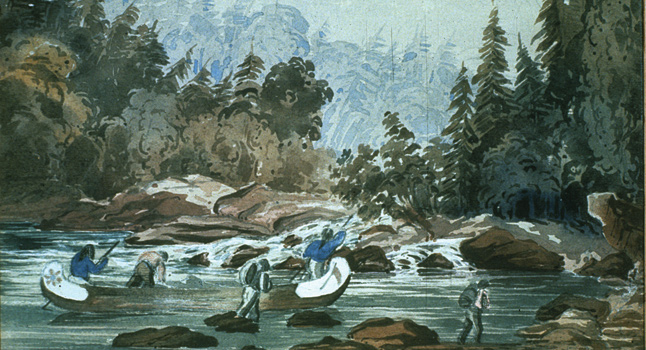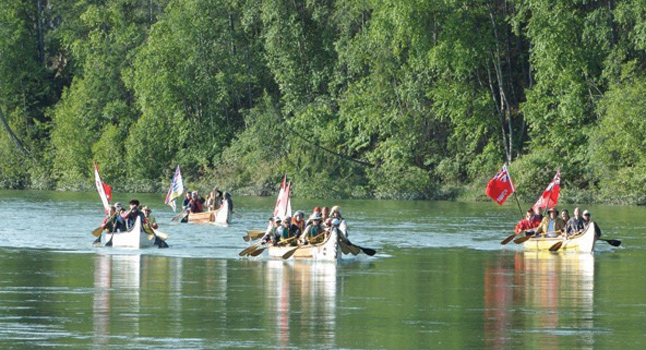 LOOKING FOR A PORTAGE, McGILLIVRAY'S RIVER" (KOOTENAI RIVER) HENRY JAMES WARRE, 1845
LOOKING FOR A PORTAGE, McGILLIVRAY'S RIVER" (KOOTENAI RIVER) HENRY JAMES WARRE, 1845
David Thompson
Downstream on the Columbia in 1811
By Jack Nisbet
Editor's note: The North American David Thompson Bicentennials took place between 2007 and 2009. This year marks another bicentennial for the surveyor and fur trader, for his extraordinary exploration of the Columbia River.
The easiest way to keep track of North West Company fur agent David Thompson's considerable activities in the year 1811 is by crew and canoe. At the tail end of January of that year, after a tough crossing of the Rocky Mountains over Athabasca Pass, Thompson consolidated his most trustworthy men at the junction of the Canoe and Columbia rivers, the northernmost hairpin turn of the big river. He dispatched a Nahathaway Cree hunter named Yellow Bird to pile up moose for food, then fanned the remainder of his bare-bones crew out to search for birch bark to make a canoe. The three voyageurs – Pierre Pareil, Joseph Cote and Rene Vallade – found no bark suitable for the job.
After careful consideration, Thompson had them fell a large cedar tree and set to work constructing a plank canoe of his own design. Over the next several weeks, a hybrid vessel sewn together with spruce roots took shape in the place known from then on as Boat Encampment. On April 17, the four men set off upstream, making for Thompson's original Kootanae House post at the Columbia's source lakes and the trade route he had established over the previous four years west of the Continental Divide.
It was more of a slog than a paddle, with days spent wearing snowshoes and pulling the boat over ice. The cedar planks leaked like crazy, and much time was spent making and thawing "Pine Gum" to seal the cracks. On May 2, they tore into their trade goods and "put a stripe of Linnen well gummed over every Seam." In spite of all their efforts, "the Canoe leaked very much."
It took more than two weeks to reach an open channel, but in early May they met two "fine steady" Iroquois whom Thompson immediately engaged: Charles in the bow, "being an excellent Canoe man," and Louis "to Hunt & be the foreman or Steersman of a Canoe." The new crew worked their way past Kootanae House and carried the 26-foot long boat across the short portage to the Kootenai River. Headed downstream now, they swept south across the 49th parallel and into modern-day Montana.
At the mouth of the Fisher River, they abandoned Thompson's first cedar plank canoe and purchased horses to cross over to the Clark Fork drainage via a tribal trail that followed the Fisher and Thompson rivers. From this point on Thompson met free trappers every day, and engaged one particular Iroquois named Ignace, "to be Steersman of my canoe."
From Saleesh House, Thompson continued on horseback, traveling downstream toward Lake Pend Oreille. Spring runoff made for soggy riding, and when Ignace, his latest Iroquois hire, was nearly swept away fording a creek, Thompson camped near a cedar grove to construct plank canoe No. 2. The men sewed this one together with cedar instead of the preferred spruce roots and completed the craft in only seven days. Thompson, always critical, made several design changes on the fly and pronounced the cedar root cordage "weak."
Thompson's crew had constructed Kullyspel House near modern Hope in the fall of 1809; since then it had served mostly as a warehouse for goods and furs. When the travelers found "no person, nor any writing" there, Thompson had no choice but to continue across Lake Pend Oreille. Still struggling with leaks in his new canoe design, he put ashore below the "Sandy Point" that marks the location of the city of Sandpoint and "gummed the Canoe which from the House has been so leaky as to keep a man continually bailing out water."
From the Pend Oreille River's outlet at Dover he continued downstream past Albeni Falls to a Kalispel encampment near the town of Cusick, Wash. There the elder called Le Bon Vieux informed Thompson that Finan McDonald was staying at Spokane House, and before long the crew had secured fresh horses to make their next portage, between the Pend Oreille and Spokane drainages. Canoe No. 2 remained behind as Thompson and his growing crew, including experienced translator Michel Boulard, moved south to the Spokane, then back north through the Colville Valley to Kettle Falls. There Thompson spent another frustrating few days looking for good birch bark before retreating to a grove of small branchy cedar on Mill Creek, just north of Colville. He and his men fashioned cedar plank canoe No. 3, dragged it the eight miles back to Kettle Falls and tossed it into the main stem of the Columbia on July 3. After six full months of preliminaries, the surveyor was ready to make his 10-day, 700-mile run to the Pacific.
For this trip, Boat Encampment veterans Pierre Pariel and Joseph Cote joined Michel Boulard and free hunters Michel Bourdeaux and Francois Gregoire as paddlers. The Iroquois Charles and Ignace took their seats at the bow and stern respectively. A San Poil couple came along as translators of the unfamiliar Interior Salish languages they would encounter downstream. It was a crack crew, and they did steady work on the trip that entered Thompson's name into modern history books as the first surveyor of the Columbia's entire length.
But in the larger scheme of events, this section of the river represented simply another leg of a much longer journey. It took six months for the Nor'Westers to build the three boats and cover the water and overland miles that got them to Kettle Falls. Over the next nine months, Thompson and various groups of men and women would cover all those river miles twice over, and build no less than seven more full-sized cedar plank cargo canoes. They ended up right back at Kettle Falls, ready to shove off for the upstream paddle back to Boat Encampment, where it all began. In the fur trade world, the river ran an endless circle. And Thompson's strange plank canoes became the model that grew into the Columbia River bateaux, used to haul goods and furs over the next four decades for both the Columbia and Fraser River fur districts.
The U.S. David Thompson Bicentennials Partnership and the Friends of Scotchman Peaks Wilderness commissioned the writing of this story.
Brigade paddles into county

The 2011 David Thompson Columbia River Brigade lands in three Bonner County communities in June. PHOTO COURTESY DAVID THOMPSON COLUMBIA RIVER BRIGADE
Commemorating David Thompson's historic journey down the Columbia River in 1811, a group is paddling voyageur canoes along the 1,200-mile route from Invermere, British Columbia, Canada, all the way to Astoria, Ore., from June 1 to July 16. And they will spend three of those days in Bonner County, arriving in Clark Fork, Sunday, June 12, Dover June 13, and Oldtown June 14.
The twice-annual Columbia Express used Thompson's route for 50 years to go across the Rocky Mountains, which was later adapted by the Hudson's Bay Company to become the York Factory Express.
The 2011 David Thompson Columbia River Brigade is planning to make a big entrance at Clark Fork. Landing at the mouth of Mosquito Creek, the brigade will re-create a welcoming ceremony at the river with a traditional black powder gun firing, followed by a procession into town.
Two days prior to the landing, historian and author Jack Nisbet and Kalispel tribal leader Francis Cullooyah will present a program June 10 at the Clark Fork/Hope Senior Center.
According to Ann Ferguson of the Bonner County Historical Museum, all three communities will feature the Mapmaker's Eye exhibit, and Nisbet will also give presentations in Dover and Oldtown. For more details, look up http://2011brigade.org or http://www.BonnerCountyHistory.org.
– Billie Jean Plaster
|